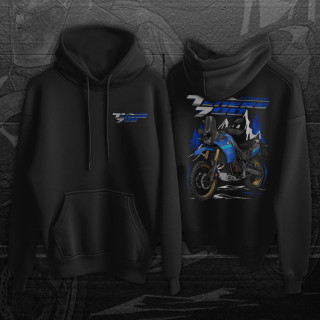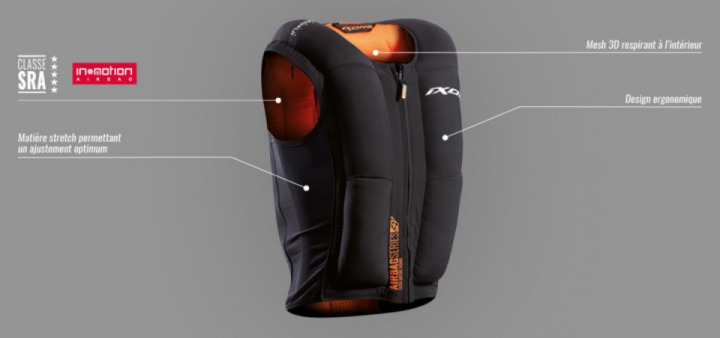Honda has patented a new type of airbag system for motorcycles, which would rapidly inflate in a crash or fall situation, wrap around the rider's torso in a great big hug, and detach from the bike to protect the rider when the two are separated.
This patent has been dug up by our old friend and erstwhile colleague Ben Purvis, who now writes for Cycle World. Ben has always had an eagle eye for patent applications, and some serious kung fu when it comes to the arcane process of hunting down particularly interesting ones.

Honda has been looking at motorcycle airbag systems for decades now; the company announced the first bike-mounted airbag back sometime in 2005, built into its Goldwing touring sofa. But the idea hasn't really caught on; the 2023 Goldwing remains to our knowledge the only motorcycle you can buy with an airbag built in.
The market seems to have shifted more toward airbag-equipped riding gear; I've been getting around for a couple of years now with a Klim vest under my jacket, fitted with an AI-controlled In&Motion airbag system, which, perhaps sadly, hasn't had a chance to go off yet. There's airbag protection built into race leathers as well, as used by MotoGP riders among others. And in some senses, this gear is potentially more effective, since it completely surrounds the rider's torso and/or legs, so it'll stay with you on a decent slide down the road.
But at the end of the day, these all require an active choice on the rider's part. Honda still thinks there's promise in the idea of bike-mounted systems that'll work whatever you happen to be wearing that day, and its engineers are apparently continuing to file patents for novel ways to get the job done.

The latest, as Ben reports, is a bike-mounted system that aims to work more or less like a jacket-mounted system. That is to say, it'll fire from aboard the bike, but it's designed to wrap around the rider's torso like the world's fastest hug, and hang on. During the process of firing, it'll recognize when it's fully inflated, cut off the gas feed and seal the airbag. It'll then detach from the bike altogether and cling to the rider.
Where the Goldwing airbag fires more or less from the dash, this detachable airbag needs to fire from lower down, so it can come up under the arms of a rider holding the handlebars. Thus, according to Ben, the patent covers two potential locations for the system. One in the front of the rider's seat, and one just behind it.
Now, if you've never seen an airbag go off, it might be worth taking a quick look at this live-on-stage demo of the Goldwing airbag at around 50 seconds in. Suffice to say, these things are explosively fast, reaching full inflation in the blink of an eye, with a resounding bang. It's a brave man sitting on that bike for the demo.

The idea of something exploding like that from the front of the rider's seat is frankly pretty frightening. I know what I put on the front of my rider's seat, and the idea of things exploding underneath or into that does not fill me with glee. On the other hand, having the airbag fire from behind the rider has its own set of issues; motorcyclists' backsides come in a variety of shapes and sizes, some of them tending toward the extremes, and again I can't see people queueing up to sit on something that's liable to hoist them aloft on an instant yoga ball during a moment that's already quite stressful enough.
Mind you, Honda's patent drawings appear to solve this issue by showing it fitted to a heavily stepped seat – the kind that might deter larger backsides from buying it in the first place.

The other thing to consider here is passengers; we may not always, or even often, carry pillions on the back seat, but when we do, we tend to be rather fond of them, and they tend to have their arms wrapped around us in about the same places the airbag system might be hoping to explode into. Does having a passenger on board disable the system, or would the airbag deploy in a way that would forcefully eject anyone behind the rider? And if so, could such a system be easily triggered by a thumb switch if the passenger starts asking for too many bathroom breaks?
Such things will remain a mystery until Honda decides to try these devices out on a real bike instead of a patent drawing. We won't be holding our breath on that account, but the fact remains: motorcycles are tons of fun to ride, they can be economical and even practical, but they're diabolical in a crash. Kudos to Honda for continuing to seek solutions, and particularly ones that'll stay hidden until they're needed, and that don't ask riders to change their behavior.
Source: Cycle World
#Honda #Gear #Moto #Bike
 Armon "Nuc-Kle" Brown 13 Mar 2023I undastand the idea, but plz explain to me, if u drop ur bike, the airbag deploys, does that total the bike ? like it does a cage. Even though it detachable, how ez will it be to get the replacement parts for the bike. My opinion is just continue the airbag riding gear.0Reply
Armon "Nuc-Kle" Brown 13 Mar 2023I undastand the idea, but plz explain to me, if u drop ur bike, the airbag deploys, does that total the bike ? like it does a cage. Even though it detachable, how ez will it be to get the replacement parts for the bike. My opinion is just continue the airbag riding gear.0Reply





























